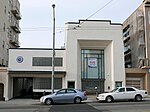The California Midwinter International Exposition of 1894, commonly referred to as the "Midwinter Exposition" or the "Midwinter Fair", was a World's Fair that officially operated from January 27 to July 5 in San Francisco's Golden Gate Park.
In 1892, U.S. President Benjamin Harrison appointed Michael H. de Young as a national commissioner to the 1893 World's Columbian Exposition held in Chicago. During the exposition in Chicago, de Young recognized an opportunity to stimulate California's economy in its time of depression. In the summer of 1893, de Young announced his plans for the California Midwinter International Exposition to be held in Golden Gate Park. One of the draws, according to de Young, was California's weather, which would allow for a fair in the middle of winter. Golden Gate Park Superintendent John McLaren fought against holding the exposition in the park claiming,"the damage to the natural setting would take decades to reverse."In August 1893, the U.S. Congress approved for the fair to be held in Golden Gate Park. Prior to the Midwinter Fair's opening day, in 1893, Isaiah West Taber won the concession to be the official photographer of the fair. Taber documented the fair from when the grading of the land began, and continued photographing the fair throughout its entirety. He sold his photos in a striking, multi-story pavilion during the exposition, on the fair grounds. At the end of the fair, he compiled about 130 of his original photographs into a souvenir book entitled Souvenir of the California Midwinter International Exposition. Much of what is known about the fair, especially visually, comes from Taber's photographs.
The fair encompassed 200 acres centered on the park's current Music Concourse. 120 structures were constructed for the exposition, and more than 2 million people visited. The fair was to feature four major buildings. These buildings included the Fine Arts Building, the Agriculture and Horticulture Building, the Mechanical Arts Building, and the Manufacturers and Liberal Arts building. The Fine Arts building has become the M.H. de Young Memorial Museum (and has been rebuilt in a much different design). Other major attractions include the park's famed Japanese Tea Garden, Bonet's Tower, the amusement attractions, and the many cultural exhibits.











